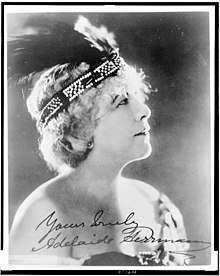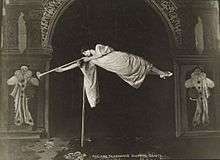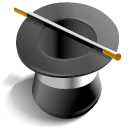Adelaide Herrmann
| Adelaide Herrmann | |
|---|---|
 Herrmann as Sleeping Beauty | |
| Born |
Adelaide Scarcez (Scarsia) 1853 London, England |
| Died |
February 19, 1932 New York, NY |
Adelaide Herrmann (1853–1932) was a well-known American magician and vaudeville performer billed as "the Queen of Magic."[1] She was married to Alexander Herrmann, another magician.

Career
Adelaide Herrmann was born Adelaide Scarcez (also spelled Scarsia) in 1853 in London. Her father, who was born in Belgium, helped establish the Egyptian Hall.[1]
Herrmann herself came to New York City as a dancer for Imre Kiralfy.[1] She began her magic career as assistant to her husband, magician Alexander Herrmann. They married in 1875 at City Hall, where New York City Mayor William H. Wickham performed their ceremony.[1] Together, Alexander ("Professor Herrmann" or "Herrmann the Great") and Adelaide entertained audiences with a variety of magic tricks, including escape tricks and the bullet catch trick. In 1888, the Herrmanns put on a show wherein they revealed how the spiritualist Ann O'Delia Diss Debar was a fraudulent medium in front of journalists.[2]
When Alexander died in 1896, Herrmann continued the show and later became a major star in her own right.[3][4] Following Alexander's death, she initially worked with his nephew, Leon Herrmann, but a clash of personalities led them to part ways after three seasons, each continuing with their own show. Herrmann was one of the few magicians to perform the infamous "bullet catch" trick, and possibly the only woman magician to perform the trick at the time.[1] Despite reports that she had disliked watching her husband perform the dangerous trick, on January 19, 1897, a month after his death, she stood in his place in front of a firing squad at the Metropolitan Opera House in Chicago. Surviving publicity material describes her as catching six bullets fired at her by local militiamen.[3]
Herrmann became more well-known as a magician, earning the moniker "the Queen of Magic."[1] She performed internationally, touring London and Paris to dance and perform her magic act.[5] In 1903, she made her Broadway debut at the Circle Theater.[6] She performed often with other vaudeville acts and was frequently mentioned in the New York Times.
Herrmann continued performing into her 70s until 1926, when a deadly warehouse fire in New York City destroyed her props and killed some of her animals.[7] She died at the age of 79 and is buried, along with her husband, at the Woodlawn Cemetery, New York.[3][8]
References
- 1 2 3 4 5 6 "Mme. Hermann, 79, Illusionist, is Dead [full article requires paid access]". New York Times. 20 Feb 1932. p. 15. Retrieved 7 March 2017.
- ↑ "Making Spirit Pictures: Herrmann's way of doing the Diss Debar Performance. [full article requires paid access]". New York Times. 28 May 1888. p. 5. Retrieved 7 March 2017.
- 1 2 3 Dawes, Edwin A (1979). "The Great Illusionists". Chartwell Books (New Jersey). ISBN 0-89009-240-0.
- ↑ "Adelaide, Queen of Magic". Margaret Steele. Retrieved 2007-04-12.
- ↑ "Theatrical Gossip [full article requires paid access]". New York Times. 23 July 1898. Retrieved 7 March 2017.
- ↑ "Theaters are made ready for expected Hot Spell [full article requires paid access]". New York Times. 31 May 1903. p. 11. Retrieved 7 March 2017.
- ↑ "Fire kills one man, 200 Stage Animals [full article requires paid access]". New York Times. 8 Sep 1926. Retrieved 7 March 2017.
- ↑ "History: Great entertainers". Woodlawn Cemetery. Archived from the original on 11 March 2007. Retrieved 2007-04-12.
Further reading
- Margaret Steele (Editor), Adelaide Herrmann, Queen of Magic - Memoirs, Published Writings and Collected Ephemera, Bramble Books (January 2012), ISBN 1-883647-19-3
- Mary Schendlinger, Prepare to Be Amazed: The Geniuses of Modern Magic, Annick Press (September 2005), ISBN 1-55037-927-5
- Mara Rockliff, Anything But Ordinary Addie: The True Story of Adelaide Herrmann Queen of Magic, illus. by Iacopo Bruno, Candlewick Press (2016), ISBN 978-0-7636-6841-9
